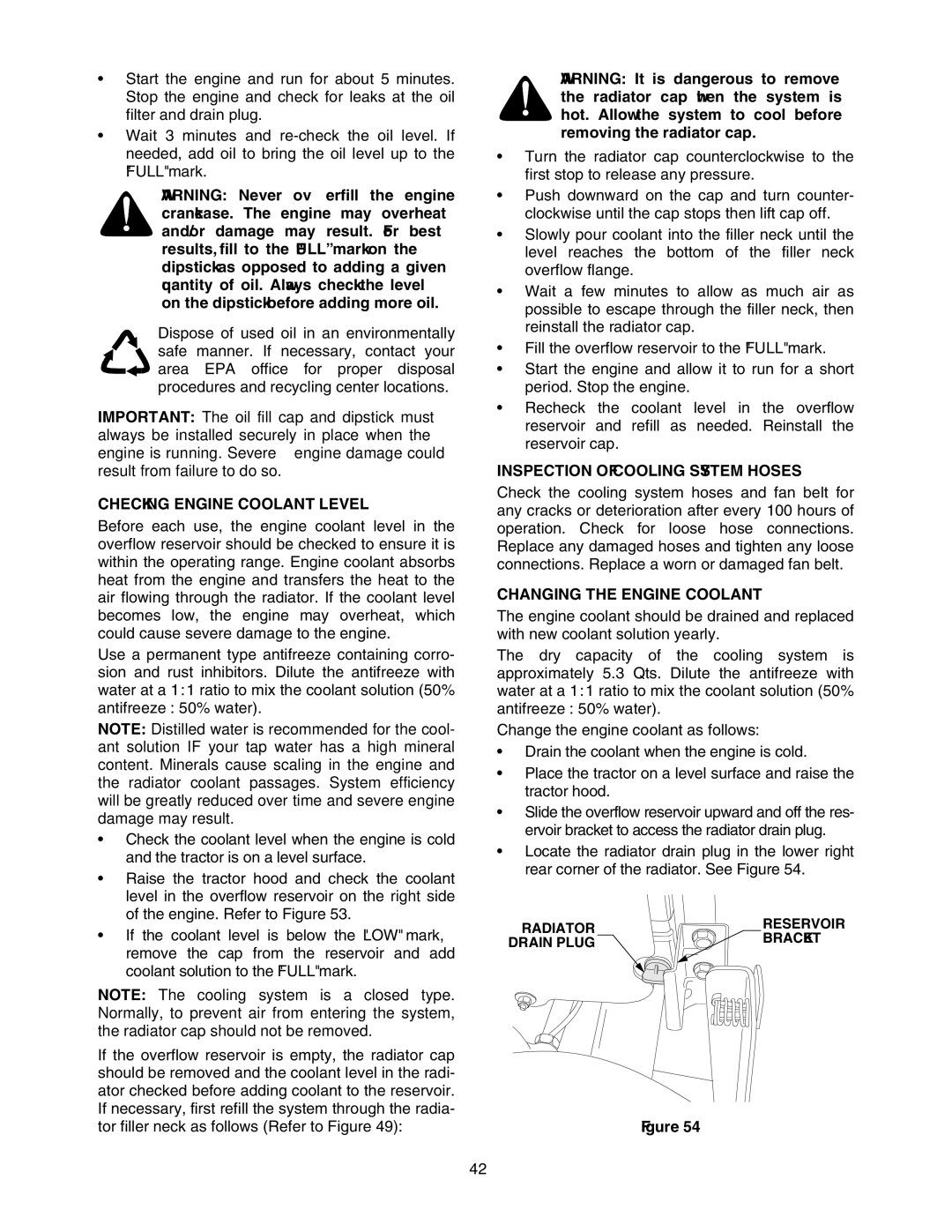
•Start the engine and run for about 5 minutes. Stop the engine and check for leaks at the oil filter and drain plug.
•Wait 3 minutes and
WARNING: Never overfill the engine crankcase. The engine may overheat and/or damage may result. For best results, fill to the “FULL” mark on the dipstick as opposed to adding a given quantity of oil. Always check the level on the dipstick before adding more oil.
Dispose of used oil in an environmentally safe manner. If necessary, contact your area EPA office for proper disposal procedures and recycling center locations.
IMPORTANT: The oil fill cap and dipstick must always be installed securely in place when the engine is running. Severe engine damage could result from failure to do so.
CHECKING ENGINE COOLANT LEVEL
Before each use, the engine coolant level in the overflow reservoir should be checked to ensure it is within the operating range. Engine coolant absorbs heat from the engine and transfers the heat to the air flowing through the radiator. If the coolant level becomes low, the engine may overheat, which could cause severe damage to the engine.
Use a permanent type antifreeze containing corro- sion and rust inhibitors. Dilute the antifreeze with water at a 1:1 ratio to mix the coolant solution (50% antifreeze : 50% water).
NOTE: Distilled water is recommended for the cool- ant solution IF your tap water has a high mineral content. Minerals cause scaling in the engine and the radiator coolant passages. System efficiency will be greatly reduced over time and severe engine damage may result.
•Check the coolant level when the engine is cold and the tractor is on a level surface.
•Raise the tractor hood and check the coolant level in the overflow reservoir on the right side of the engine. Refer to Figure 53.
•If the coolant level is below the "LOW" mark, remove the cap from the reservoir and add coolant solution to the "FULL" mark.
NOTE: The cooling system is a closed type. Normally, to prevent air from entering the system, the radiator cap should not be removed.
If the overflow reservoir is empty, the radiator cap should be removed and the coolant level in the radi- ator checked before adding coolant to the reservoir. If necessary, first refill the system through the radia- tor filler neck as follows (Refer to Figure 49):
WARNING: It is dangerous to remove the radiator cap when the system is hot. Allow the system to cool before removing the radiator cap.
•Turn the radiator cap counterclockwise to the first stop to release any pressure.
•Push downward on the cap and turn counter- clockwise until the cap stops then lift cap off.
•Slowly pour coolant into the filler neck until the level reaches the bottom of the filler neck overflow flange.
•Wait a few minutes to allow as much air as possible to escape through the filler neck, then reinstall the radiator cap.
•Fill the overflow reservoir to the "FULL" mark.
•Start the engine and allow it to run for a short period. Stop the engine.
•Recheck the coolant level in the overflow reservoir and refill as needed. Reinstall the reservoir cap.
INSPECTION OF COOLING SYSTEM HOSES
Check the cooling system hoses and fan belt for any cracks or deterioration after every 100 hours of operation. Check for loose hose connections. Replace any damaged hoses and tighten any loose connections. Replace a worn or damaged fan belt.
CHANGING THE ENGINE COOLANT
The engine coolant should be drained and replaced with new coolant solution yearly.
The dry capacity of the cooling system is approximately 5.3 Qts. Dilute the antifreeze with water at a 1:1 ratio to mix the coolant solution (50% antifreeze : 50% water).
Change the engine coolant as follows:
•Drain the coolant when the engine is cold.
•Place the tractor on a level surface and raise the tractor hood.
•Slide the overflow reservoir upward and off the res- ervoir bracket to access the radiator drain plug.
•Locate the radiator drain plug in the lower right rear corner of the radiator. See Figure 54.
RADIATOR |
|
|
|
|
|
|
| RESERVOIR | ||
|
|
|
|
| BRACKET | |||||
DRAIN PLUG |
|
|
|
|
| |||||
|
|
|
|
|
| |||||
|
|
|
|
|
|
|
|
|
|
|
|
|
|
|
|
|
|
|
|
|
|
Figure 54
42
